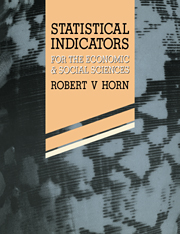Book contents
CHAPTER 4 - ECONOMIC APPLICATIONS OF INDICATORS
Published online by Cambridge University Press: 27 October 2009
Summary
Economic activity
Social scientists sometimes look with envy on economic indicators because of their seeming certainty in expressing changing phenomena in fixed and evenly spaced quantitative or value terms presented in graphs or series that lend themselves to further statistical analysis. Statistical expression and illustration are usually more concise and persuasive than verbal description. There is no denying that the multitude of statistics and graphs published in general and specialised publications, or presented on radio and television, have a major role in communicating economic changes to business people and the general public. Any criticism of their occasional inadequacies should be seen in the context of their general usefulness.
It seems to be appropriate to begin a discussion of economic indicators with this proviso in mind, because in a general textbook there is a tendency to dwell on shortcomings and limitations that are not negligible but do not vitiate necessarily the main purpose for which indicators are and can be used. This is not meant to excuse the types of errors that Huff has slated under the telling title How to Lie with Statistics (1954), with examples such as the sample with the built-in bias or the gee-whiz graph, nor the interpretative errors that are discovered so often on close scrutiny of comments on published tables and graphs.
- Type
- Chapter
- Information
- Statistical IndicatorsFor the Economic and Social Sciences, pp. 102 - 145Publisher: Cambridge University PressPrint publication year: 1993



